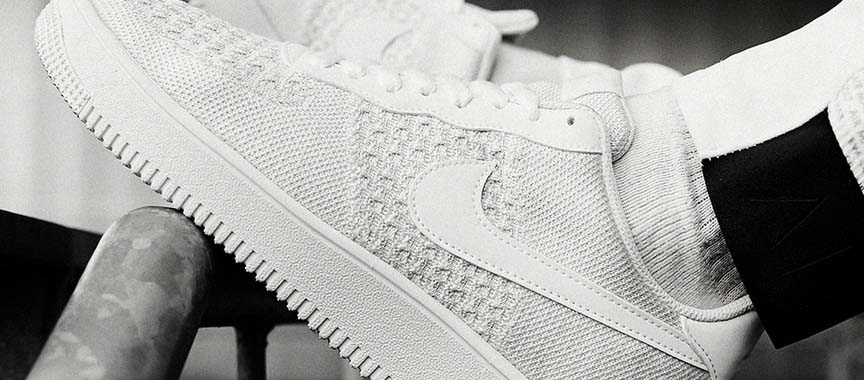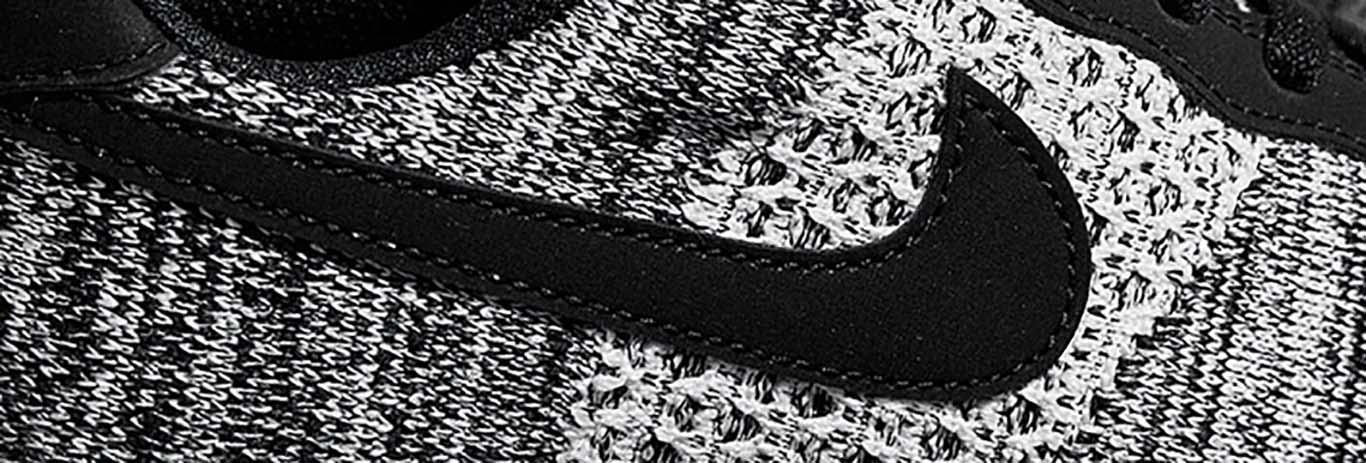Flyknit has changed the way we think about sneakers!
Allowing Nike to create more versatile and lightweight silhouettes, Flyknit technology has stepped up performance in sport, while switchin up style on the streets.
But…what exactly is Flyknit?
We’re gonna give you the low down on Flyknit tech and show how it became an essential part of your Swoosh kicks.
![]() (Image: news.nike.com)
(Image: news.nike.com)
Why Flyknit?
Before Flyknit arrived on the scene, uppers were usually all made the same way: using various materials stitched together. This method created large amounts of waste due to excess material and limited how the sneaks could be used.
With Flyknit, Nike created a seamless upper that could be built to size – reducing waste by around 60% – while also allowing the upper to be micro-engineered to suit the needs of different silhouettes. Essentially, Nike began knitting in the necessary structure and support.
Nike remains tight-lipped about the exact construction of Flyknit, but what we do know is that yarns and fabric variations are precisely engineered only where they’re needed. Then used to create a featherweight, form-fitting and virtually seamless upper. Fly look, right?
![]() (Image: news.nike.com)
(Image: news.nike.com)
Flyknit Origins
The aim for Nike was to create a lightweight yet sturdy construction that reduced waste. This has been a long-term goal for the Swoosh team; they’ve been experimenting as far back as the ‘80s with an ultra-light mesh sneaker – the Sock Racer. After the Sock Racer and numerous other attempts following, Nike found that the uppers, while lightweight and breathable, didn’t have the stability they needed.
Nike initially began working towards Flyknit due to runners’ ask for sneakers that had the qualities of a sock – a snug and supportive fit that is virtually unnoticed by the wearer.
A breakthrough came in 2008 when Flywire tech arrived on the scene. Flywire cabling used lightweight, high-strength threads to provide support exactly where it was needed, giving Nike the confidence that they could create an upper that provided the same lightweight support.
For 4 years, Nike’s leading programmers, engineers and designers experimented and researched knit tech, eventually reworking a knitting machine for socks and sweaters to create the first Flyknit uppers. Eventually, Nike successfully found a way to give sneakers the support, flexibility and breathability they needed – all in one layer.
![]() (Image: news.nike.com)
(Image: news.nike.com)
Sporting Flyknit
Flyknit was finally unveiled to the world when it dropped in 2012 on the Flyknit Racer: a featherweight running silhouette, using the innovative upper to provide a form-fitting and durable wear. Nike’s first use for Flyknit tech being on a sneaker designed for marathons showed that durability and support with a knitted upper was no longer a problem.
Since the Flyknit Racer, Nike has played around with the sport silhouettes it uses the tech on – showing just how versatile Flyknit can be.
In 2013, Eric Avar, the man behind all of Kobe Bryant’s signature sneakers, decided that it was time to change things up. With the Kobe Elite 9, Avar brought Flyknit to the courts. The Flyknit Kobe kicks gave people the same standout performance with the added benefit of a lightweight wear and quicker foot movement.
Then in 2014, Flyknit finally made its way to the pitch with the Magista soccer boots. The complete Flyknit upper gave the wearer a secure fit, while also bringing true touch and control for next-level performance. Anyone doubting Flyknit could work for top level footballers were quickly shut down when German star, Mario Gotze scored the winning goal in the 2014 World Cup final while rockin’ the Magista boots.

Flyknit Flying High
Since Flyknit arrived in 2012, it’s not only become an essential part of many sports silhouettes, but also a standout look on the streets. Sneakers such as the Vapormax Flyknit and now the Air Force 1 Flyknit 2.0 combine performance cushioning with Flyknit for statement style no matter where you rep them.
With Flyknit appearing on the feet of athletes and sneakerheads alike, it’s clear that this tech is changing sneakers as we know them – making them more versatile, lightweight and standout. Nike CEO, Mark Parker managed to predict the success of Flyknit tech when he claimed that it was not just the future of Nike, but the future of sneakers in general.
Shop the latest from Nike online at jdsports.com and at all 6 JD US locations.
Mall of America
245 East Broadway
E 241
Bloomington, MN 55425
Houston Galleria
5085 W Westheimer Rd
Houston, TX 77056
Woodfield Shopping Center
5 Woodfield Mall E120
Schaumburg, IL 60173
Greenwood Park Mall
1251 US-31 N
Greenwood, IN 46142
Polaris Fashion Place
1500 Polaris Pkwy
Columbus, OH 43240
Fashion Centre At Pentagon City
1100 S Hayes St.
Arlington, VA 22202
Keep it locked on @jdsportsus for all of our latest launches.



